
Gebel El-Arak Knife – A Link to Ancient Egypt’s Distant Beginnings
The ancient, far reaching civilizations of the world are for many people a continuous source of inspiration. Ancient, ageless myths and wonders of emerging societies and archaic technologies are not only extraordinary – but often baffling as well. From the megalithic structures of Neolithic Europe, to the mysterious Easter Island statues, all the way to the ancient Egypt – the achievements of ancient man are often difficult to fully grasp. As we endlessly explore the countless wonders that emerged from the ancient Egyptian civilization, we come upon many magnificent creations – ancient items crafted with extreme precision. One such item that is one of the earliest wonders of emerging Egypt, is the so-called Gebel el-Arak knife. A ritual item of a great and elaborate design, this knife comes from a very early, formative period of what was to become ancient Egypt as we know it today. It shows us the important early connections of the region and gives us a glimpse into the major events of the period.
Discovering the Gebel el-Arak Knife
For the pioneering Egyptologists of the 19th and 20th centuries, the predynastic period of ancient Egypt was often the most puzzling, mysterious era of its history. A variety of emerging and disappearing cultures muddled cohesion, and a lack of defining archaeological finds led to a difficult task of piecing together that puzzle and learning more about the formative years of such a lavish civilization. But with the discovery of the Gebel el-Arak knife, that far reaching picture would change immensely.
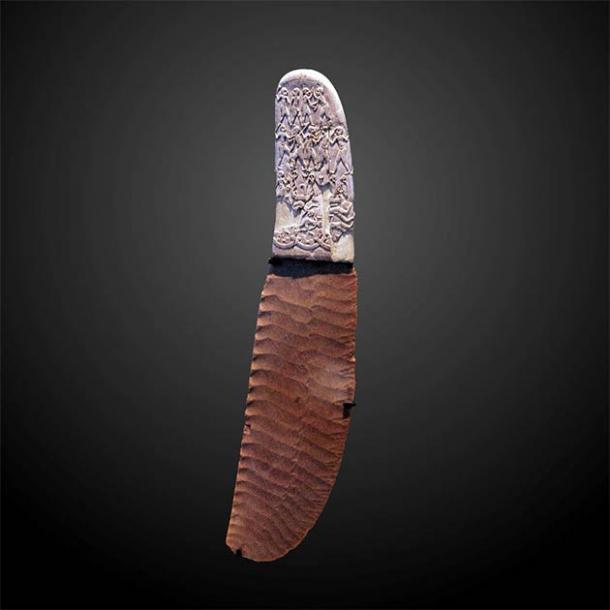
The Gebel el-Arak Knife. (Rama/CC BY SA 3.0)
During the early 1900’s, Egyptologists often had to rely on the seedy back alleys of Cairo, private antique dealers, whispered tips, and many other somewhat shady sources – all in hopes of purchasing new and defining relics of ancient Egypt. In a setting that is largely reminiscent of an exciting Indiana Jones movie, these devoted scholars and archaeologists merged with the Cairo society and scanned the black market for items of worth.
It can safely be said that many of the ancient Egyptian relics that came from such street vendors of Cairo and elsewhere where looted – men who recognized the worth in old items always disregarded the magnificence of ancient history. And thus they did not hesitate to go grave robbing and sifting through known ancient locations for items of worth. During that period, any tourist could have purchased a proper mummy of an animal or even a person – for the lowest amounts of money imaginable.
But finding a truly ground-breaking artifact was often near impossible. Nonetheless, one French Egyptologist did find it. That man was Georges Aaron Bénédite, one of the leading men in his field. In February 1914, he purchased a pristine, highly-decorated ivory and flint knife – he discovered it in two pieces at a Cairo antique dealership owned by Mr. Nahman.
The Back Alley Markets of Dusty Cairo and the Treasures They Kept
Bénédite at once recognized that such a lavish item held significance, and knew from the style of its manufacture that it certainly comes from the predynastic period. The Cairo antiques dealer didn’t recognize the item as a knife. He was selling the handle and the blade as two separate pieces. The man stated to have discovered the handle part at a location he called Gebel el-Arak (جبل العركى), a historic plateau that is located roughly 25 miles (40 km) from the important Ancient Egyptian city of Abydos.
But when he presented Bénédite a lot of items – among which was the flint blade - the dealer said he had recently discovered those at Abydos itself. Thus Bénédite was able to conclude that the complete knife certainly belonged in Abydos and was discovered there, as such a significant item would have no place at the Gebel el-Arak site.
- Predynastic Egypt: Life Before the Pyramids
- Khopesh—The Egyptian Sword that Forged an Empire
- The Giants of Ancient Egypt: Part 1 - A Lost Legacy of the Pharaohs

Detail of the battle (Rama/CC BY SA 3.0) and animal (Rama/CC BY SA 3.0) scenes on the Gebel el-Arak Knife.
Bénédite purchased the item at once for the Paris’ Louvre museum. Excited, he immediately wrote about his discovery to the Louvre’s head of the department of Egyptian antiquities, Charles Boreux. Dated to March 16, 1914, the letter survives – and from the following excerpt we can understand the weight that the discovery carried at the time.
“[...] an archaic flint knife with an ivory handle of the greatest beauty. This is the masterpiece of predynastic sculpture [...] executed with remarkable finesse and elegance. This is a work of great detail [...] and the interest of what is represented extends even beyond the artistic value of the artifact. On one side is a hunting scene; on the other a scene of war or a raid. At the top of the hunting scene [...] the hunter wears a large Chaldean garment: he head is covered by a hat like that of our Gudea [...] and he grasps two lions standing against him. You can judge the importance of this asiatic representation [...] we will own one of the most important prehistoric monuments, if not more . It is, in definitive, in tangible and summary form, the first chapter of the history of Egypt.”
The passion with which Bénédite writes, and the acute recognition of the styles and influences presented on the artifact, clearly shows us that he and other Egyptologists had a good understanding of the earliest influences on the predynastic period. And through the details and scenes depicted on the knife, we can certainly understand a lot more about the era.
The Gebel el-Arak knife has a Wealth of Intricate Details
The Gebel el-Arak knife is old – very old. It is dated to somewhere between 3450 and 3200 BC, predating the construction of the Great Pyramid by almost an entire millennium. In total, the knife is about 28 centimeters long (11 inches) and consists of a curved flint blade that is approximately 19 centimeters long (7.5 inches). The ivory handle is 9.5 centimeters long (3.7 inches).
One glance at the extremely elaborate and rich design tells us that this was not a knife to be used in combat, but rather a ritual, ceremonial piece to be displayed. One side of the richly carved ivory handle displays apparent hunting scenes filled with animals, while the opposite side shows men in combat and war.
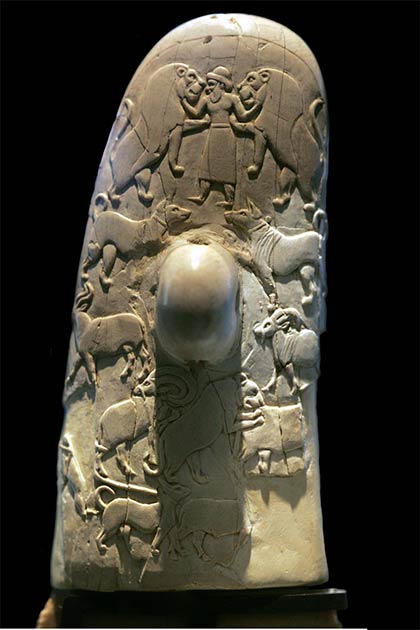
One side of the richly carved ivory handle displays apparent hunting scenes filled with animals. (Rama/CC BY SA 3.0)
The flint blade was created with the traditional Neolithic flaking method – but with immense precision and attention to detail. One side is ripple flaked to such minute detail that it is razor sharp. The opposite side is sanded smooth. It is also surprisingly thin – being only 6 millimeters (.24 of an inch) thick.
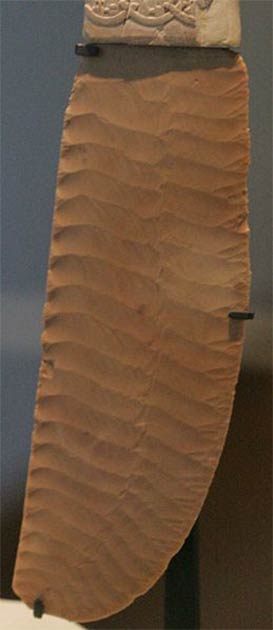
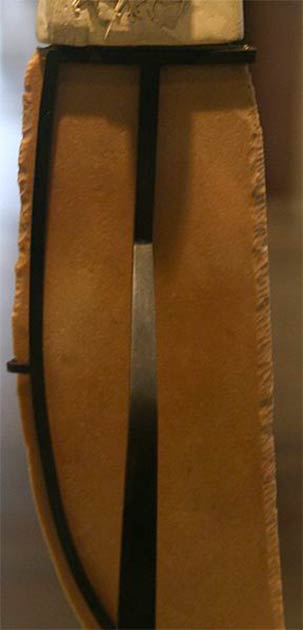
Ripple-flaked side (Iry-Hor/CC BY SA 3.0) and polished side (Iry-Hor/CC BY SA 3.0) of the Gebel el-Arak Knife.
The “back” side of the ivory handle is the first part we should focus on. In its center there is a raised knob through which a cord could be inserted for carrying the knife. Dominating the elaborate carved scene is the so-called “Master of Animals” - a symbol that frequently appears in Mesopotamian art. Scholars sometimes identify this figure as the Mesopotamian god El.
The figure is displayed in usual Mesopotamian style clothing, flanked by two prancing lions and a variety of different animals. While it is correct to use the term Mesopotamian, a more precise description of the style is Sumerian. It is likely the figure is not actually El, but the Sumerian King of Uruk, wearing the traditional symbol of his kingship – a shepherd cap.
The other side of the Gebel el-Arak knife has a different scene: a tiered depiction of warfare. Two groups of soldiers battle it out in these scenes: the men with shaved heads are most likely Sumerians, while the long haired men are Egyptians. All are naked except for their penis sheaths. This battle scene is also one of the first depictions of naval warfare in the world: battle ships are depicted in action.
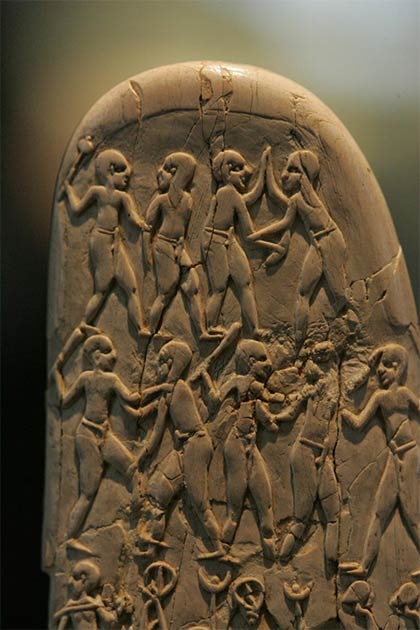
Detail of warfare depicted on the Gebel el-Arak knife. (Rama/CC BY SA 3.0)
Under the Influence of Greater Civilizations
Now, you are probably wondering: If this is a predynastic Egyptian knife, why does it display a significant Mesopotamian / Sumerian style? Well, to answer this question, we need to understand the early relations between Mesopotamia and Egypt’s earliest cultures.
Trade relations apparently developed between the two as early as the 4th millennium BC, with the Uruk Period of the Mesopotamian civilization having significant influences on the emerging Naqada II culture that is the key predecessor to the later ancient Egyptian civilization. During this period there was abundant trade between the region of Egypt and the Near East. Possible trade routes from Mesopotamia could have been fully by sea, or across land as well.
This period holds significance as being a major stage in ancient Egyptian development, under the influence of the more advanced Mesopotamia. It is during this stage that major parallels between the two occurred, and proto literacy entered Egypt. The Mesopotamian influence on predynastic Egypt lasted for roughly 250 years, until the emergence of Dynasty I, and a more fleshed out, unique Egyptian art and cultural style.
Interestingly enough, the Gebel el-Arak knife is not the only of its type to be discovered and associated with predynastic Egypt. Several similar ceremonial daggers have been discovered, and it can be agreed that they were an important symbol of power for the era. They all follow the same design elements – with flint and ivory being the dominant materials in use.
One of the finest of these discoveries – coming close to eclipsing the majesty of Gebel el-Arak knife – is the simply named Ritual Knife. This item was unearthed by a French archaeologist, Jean-Jacques de Morgan during the 19th century, in a tomb at the Abu Zeidan location near the ancient Egyptian town of Edfu. Currently displayed at the Brooklyn Museum, this knife has stunning attention to detail. The handle, made from Elephant ivory, is completely covered by intricately carved animals – 227 of them are artfully arranged in 10 separate rows. The jaw dropping intricacy tells us that many hours went into its creation by highly skilled artisans of the era.

Brooklyn Museum ritual knife. (Brooklyn Museum/CC BY SA 3.0)
To Imitate is to Learn
A similar knife to that one is the Pitt-Rivers knife. As was the case with the Gebel el-Arak knife, it was bought in the 19th century by Reverend G. Chester, who travelled through Egypt and bought the knife from a local antiques dealer. The latter reported finding it at a location called Sheikh Hamada, which is near the Egyptian city of Sohag. The immaculate flint blade is almost identical to the Gebel el-Arak knife, just somewhat larger. The ivory handle of the Pitt-Rivers knife displays a selection of Egyptian animals organized in six rows – including some unique animals such as the ibis, hartebeest, Barbary sheep, and jackals.
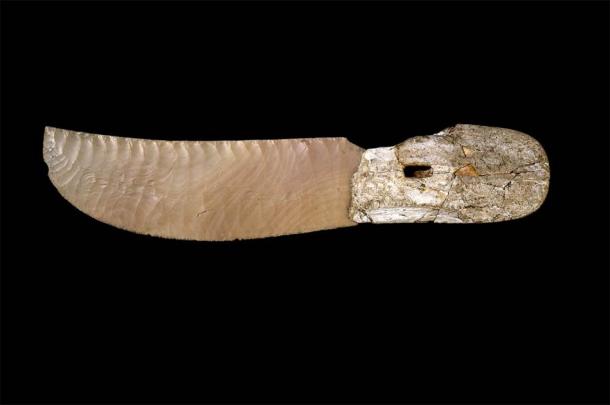
The Pitt-Rivers knife. (The Trustees of the British Museum/CC BY NC SA 4.0)
The Gebel el-Arak knife, since its chance discovery in some backwater Cairo shop, has been widely considered by scholars and Egyptian civilization enthusiasts as one of the major monuments of predynastic Egyptian art. Intricate, immaculate, and highly influential, this knife is an important insight into predynastic development – a greatly important thing in a phase when written texts do not exist. It tells us of an obvious and very important connection between Egypt and Mesopotamia, which surpassed trade and economy, and penetrated deep into the cultural development of an emerging civilization that would surpass its contemporaries and ascend to the crowning heights of human development.
And not only this – the Gebel el-Arak knife gives us important insights into the development of human civilizations as a whole. It provides proof that more advanced civilizations actively influenced and helped other cultures to reach equal technological standards. One theory suggests that Mesopotamian craftsmen and artisans were actively working in Egypt and teaching and influencing the Egyptian artisans who created the Gebel el-Arak knife.
To accept and imitate the art style of more advanced builders is a sure path towards great achievements – and the later emerging Egypt certainly showed this: picking up writing and many other important technologies from the Mesopotamians, only to evolve into a unique identity that would later on show no traces of their distant, predynastic roots and influences of their neighbors. This demonstrates how the people near the Nile were always destined for important deeds.
The Dawn of a New Era
The predynastic period of Egypt’s long history remains an enigmatic era. But even so, it has provided some crucial details on how one of the world’s finest civilizations developed – step by step, century by century. And to be under direct influence from the human civilizational progenitors such as the Mesopotamians certainly helped place the inhabitants of the Nile’s fertile valleys onto a success-bound trajectory.
Top Image: The Gebel el-Arak Knife (Rama/CC BY SA 3.0) and detail of one side of the ivory handle. (Rama/CC BY SA 3.0)
References
Adams, B. and Hendricks S. and Friedman R. 2004. Egypt at Its Origins: Studies in Memory of Barbara Adams. Peeters Publishers.
Cooper, J. and Schwartz, G. 1996. The Study of the Ancient Near East in the Twenty-first Century. Eisenbrauns.
Shaw, I. 2003. The Oxford History of Ancient Egypt. OUP Oxford.
Unknown. The Gebel el-Arak Knife. Sumerian Shakespeare. [Online] Available at: http://sumerianshakespeare.com/748301/748322.htm
















Comments
Would a people really treat their OWN ancestors like those people treat those mummies and relics? Obviously no. Keep that in mind when reading/thinking about the whole subject in general.
Nobody gets paid to tell the truth.
One of the most beautiful pictures of a knife that I've ever seen. Really, all 3 are impressive. Thanks for writing this article.